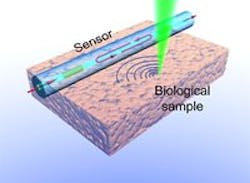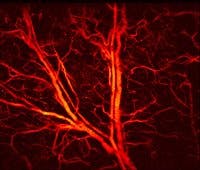Novel photoacoustic technology pairs fiber laser light, ultrasound to image tissue
Researchers at Jinan University's Institute of Photonics Technology (Guangzhou, China) have developed a photoacoustic imaging technique that may have potential applications in wearable devices, instrumentation, and medical diagnostics. It uses fiber-optic ultrasound detection, exploiting the acoustic effects on laser pulses via the thermoelastic effect—temperature changes that occur as a result of the elastic strain.
"Conventional fiber-optic sensors detect extremely weak signals by taking advantage of their high sensitivity via phase measurement," says Long Jin, the lead researcher. These same sorts of sensors are used in military applications to detect low-frequency (kilohertz) acoustic waves. However, they don't work so well for ultrasound waves at the megahertz frequencies used for medical purposes because ultrasound waves typically propagate as spherical waves and have a very limited interaction length with optical fibers. The new sensors were specifically developed for medical imaging, Jin says, and can provide better sensitivity than piezoelectric transducers currently used.
The research team designed an ultrasound sensor that is essentially a compact laser built within the 8-µm-diameter core of a single-mode optical fiber. "It has a typical length of only 8 mm," Jin says. "To build up the laser, two highly reflective grating mirrors are UV-written into the fiber core to provide optical feedback." This fiber then gets doped with ytterbium and erbium to provide sufficient optical gain at 1530 nm. They use a 980 nm semiconductor laser as the pump laser.
"Such fiber lasers with a kilohertz-order linewidth—the width of the optical spectrum—can be exploited as sensors because they offer a high signal-to-noise ratio," says research team member Yizhi Liang, an assistant professor at the Institute of Photonics Technology.
The ultrasound detection benefits from the combined technique because side-incident ultrasound waves deform the fiber, modulating the lasing frequency. "By detecting the frequency shift, we can reconstruct the acoustic waveform," Liang says.
The team does not demodulate the ultrasound signal, extracting the original information, using conventional interferometry-based methods or any additive frequency locking. Rather, they use another method called "self-heterodyning," where the result of mixing two frequencies is detected. Here, they measure the radio frequency-domain beat note given by two orthogonal polarization modes of the fiber cavity. This demodulation also intrinsically guarantees a stable signal output.
The fiber laser-based ultrasound sensors offer opportunities for use in photoacoustic microscopy. The researchers used a focused 532 nm nanosecond pulse laser to illuminate a sample and excite ultrasound signals. They place a sensor in a stationary position near the biological sample to detect optically induced ultrasound waves.
A photoacoustic microscope image of blood vessels and capillaries in a mouse's ear (size: 2.7 × 2.7 mm2) is shown. (Image credit: Long Jin)
"By raster scanning the laser spot, we can obtain a photoacoustic image of the vessels and capillaries of a mouse's ear," Jin says. "This method can also be used to structurally image other tissues and functionally image oxygen distribution by using other excitation wavelengths—which takes advantage of the characteristic absorption spectra of different target tissues."
"The development of our laser sensor is very encouraging because of its potential for endoscopes and wearable applications," Jin says. "But current commercial endoscopic products are typically millimeters in dimension, which can cause pain, and they don't work well within hollow organs with limited space."
For more information, please visit ipt.jnu.edu.cn/en.

